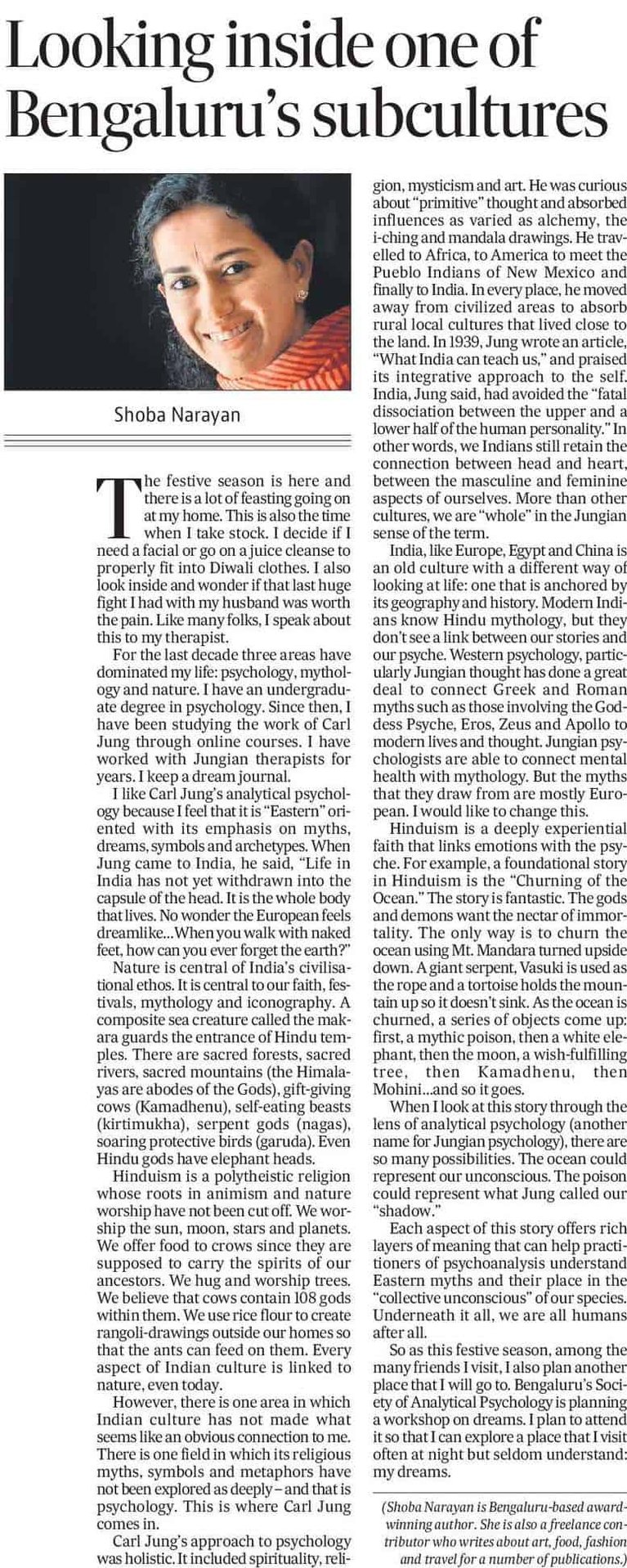The festive season is here and there is a lot of feasting going on at my home. This is also the time when I take stock. I decide if I need a facial or go on a juice cleanse to properly fit into Diwali clothes. I also look inside and wonder if that last huge fight I had with my husband was worth the pain. Like many folks, I speak about this to my therapist.
For the last decade three areas have dominated my life: psychology, mythology and nature. I have an undergraduate degree in psychology. Since then, I have been studying the work of Carl Jung through online courses. I have worked with Jungian therapists for years. I keep a dream journal.
I like Carl Jung’s analytical psychology because I feel that it is “Eastern” oriented with its emphasis on myths, dreams, symbols and archetypes. When Jung came to India, he said, “Life in India has not yet withdrawn into the capsule of the head. It is the whole body that lives. No wonder the European feels dreamlike…When you walk with naked feet, how can you ever forget the earth?”
Nature is central of India’s civilisational ethos. It is central to our faith, festivals, mythology and iconography. A composite sea creature called the makara guards the entrance of Hindu temples. There are sacred forests, sacred rivers, sacred mountains (the Himalayas are abodes of the Gods), gift-giving cows (Kamadhenu), self-eating beasts (kirtimukha), serpent gods (nagas), soaring protective birds (garuda). Even Hindu gods have elephant heads.
Hinduism is a polytheistic religion whose roots in animism and nature worship have not been cut off. We worship the sun, moon, stars and planets. We offer food to crows since they are supposed to carry the spirits of our ancestors. We hug and worship trees. We believe that cows contain 108 gods within them. We use rice flour to create rangoli-drawings outside our homes so that the ants can feed on them. Every aspect of Indian culture is linked to nature, even today.
However, there is one area in which Indian culture has not made what seems like an obvious connection to me. There is one field in which its religious myths, symbols and metaphors have not been explored as deeply – and that is psychology. This is where Carl Jung comes in.
Carl Jung’s approach to psychology was holistic. It included spirituality, religion, mysticism and art. He was curious about “primitive” thought and absorbed influences as varied as alchemy, the i-ching and mandala drawings. He travelled to Africa, to America to meet the Pueblo Indians of New Mexico and finally to India. In every place, he moved away from civilized areas to absorb rural local cultures that lived close to the land. In 1939, Jung wrote an article, “What India can teach us,” and praised its integrative approach to the self. India, Jung said, had avoided the “fatal dissociation between the upper and a lower half of the human personality.” In other words, we Indians still retain the connection between head and heart, between the masculine and feminine aspects of ourselves. More than other cultures, we are “whole” in the Jungian sense of the term.
India, like Europe, Egypt and China is an old culture with a different way of looking at life: one that is anchored by its geography and history. Modern Indians know Hindu mythology, but they don’t see a link between our stories and our psyche. Western psychology, particularly Jungian thought has done a great deal to connect Greek and Roman myths such as those involving the Goddess Psyche, Eros, Zeus and Apollo to modern lives and thought. Jungian psychologists are able to connect mental health with mythology. But the myths that they draw from are mostly European. I would like to change this.
Hinduism is a deeply experiential faith that links emotions with the psyche. For example, a foundational story in Hinduism is the “Churning of the Ocean.” The story is fantastic. The gods and demons want the nectar of immortality. The only way is to churn the ocean using Mt. Mandara turned upside down. A giant serpent, Vasuki is used as the rope and a tortoise holds the mountain up so it doesn’t sink. As the ocean is churned, a series of objects come up: first, a mythic poison, then a white elephant, then the moon, a wish-fulfilling tree, then Kamadhenu, then Mohini…and so it goes.
When I look at this story through the lens of analytical psychology (another name for Jungian psychology), there are so many possibilities. The ocean could represent our unconscious. The poison could represent what Jung called our “shadow.” Each aspect of this story offers rich layers of meaning that can help practitioners of psychoanalysis understand Eastern myths and their place in the “collective unconscious” of our species. Underneath it all, we are all humans after all.
So as this festive season, among the many friends I visit, I also plan another place that I will go to. Bangalore’s Society of Analytical Psychology is planning a workshop on dreams. I plan to attend it so that I can explore a place that I visit often at night but seldom understand: my dreams.
Shoba Narayan is Bangalore-based award-winning author. She is also a freelance contributor who writes about art, food, fashion and travel for a number of publications.



-k4lD-U204025897261YmH-250x250%40HT-Web.jpg)




Leave A Comment